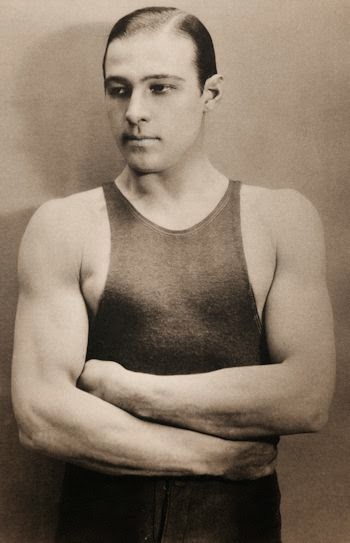CMBA Film Passion 101 Blogathon: The Four Horsemen of the Apocalypse (1921)
 |
| Rudolph Valentino portrait by Nelson Evans as Julio |
Accepted
cinema history tells us that Rudolph Valentino’s star-making film was the 1921
blockbuster The Sheik. While this is, in part, arguably true, the
real landmark was a small film entitled The
Eyes of Youth in which Valentino played a paid correspondent to help Milton
Sills win a divorce from poor Clara Kimball Young. This small landmark performance put Rudolph
Valentino under the gaze of the powerful scenarist June Mathis who was in the
process of writing the gigantic film The
Four Horsemen of the Apocalypse. It
was Mathis who fought hard and pushed for Valentino to win the coveted part of
Julio Desnoyers.
My first
exposure to Valentino was in another film, also based on a novel by Spanish
author Vincente Blasco-Ibanez, Blood and
Sand. It was, however, my first
viewing of the 1921 epic that really exposed me to Valentino’s terrific talent
and ability as an actor of range. A
range far beyond the display of The Sheik
which is commonly referred to as the star-making film.
Ibanez’
sprawling novel tells the tale of two branches of a family, split by cultural
differences and values and, ultimately, by World War I. Mathis expertly culled the massive tale down
to a tightly told story that is as gripping today as it had to have been in late
1920 when the film was first released.
Valentino’s
appearance comes relatively early in the film, dressed in his gaucho attire and
with his doting grandfather (played by Pomeroy Cameron) in the seedy Boca
district where Julio revels and dances the tango. If ever there were a moment on screen that a
star was truly born, the famed “Tango Sequence” is it for Valentino. Once he has eyeballed Beatrice Domiguez on
the dance floor with her lesser partner, it’s easy to see he absolutely will
take what he wants and what that is, is her.
Once he has disposed of the pasty opponent, he slinks into the dance
like a panther taking her with him. As
they circle the floor, the various miscreants and patrons nod and applaud their
approval. The dance progresses and ends
with a slow, lingering kiss in profile. It
is said the women in the audience grew faint, in 2013, you can still have a
great understanding why. It is not only
a star-making moment, it’s a terrific piece of filmmaking.
While I had
an appreciation for Valentino long before I saw this film, I’d seen a few silent
films (often on my bedroom wall in super 8 in the pre VHS and DVD days). But seeing this film spoke to me of the power
of silent film. The epic story distilled
down to the stories of the two families and, in particular, the story arc of
Julio, was quite simply engrossing story telling. This film was made at the mid-point of the silent era. Itself
only five years gone from D.W. Griffith’s The
Birth of a Nation and technically a much more complex film. It could have
been 20 years ahead with the progress made in the art of telling the
story. Similarly, if you look at F.W.
Murnau’s Sunrise of 1927, the leaps
in technology and the changes in the visual story arc from Four Horsemen and Sunrise,
they’re like night and day. Sadly, Sunrise was very nearly the mark of the end of the silent era with the synchronized soundtrack. What a film to exit on, however.
For this
viewer, however, even without Valentino, The
Four Horsemen of the Apocalypse is a film that still stands the true test
of time. It helped inspire a passion for
early cinema and it is a film that still holds up with repeated viewings. To me that is the key point, if you find a
silent film you love, it will inspire you to seek out more of them. Tragically, the Photoplay Productions
restoration of Four Horsemen of the
Apocalypse is not commercially available, at least not yet. It is shown in semi-regular rotation on
Turner Classic Movies. Happily, if you
have an interest in Valentino, loads of his films are available on DVD. |
| Six-Sheet poster from the original release |
That said, lest you think I obsess too much over Valentino, here are ten silent films (most on DVD) that I think, in my humble opinion, will bring you pleasure and suck you into the vortex of early film. You won’t regret it.
In no particular order:Stella Maris; Tol’able David; Sunrise; The Thief of Bagdad; The Son of the Sheik (I HAD to put a Valentino in there), The Wind (run on TCM); The Patsy; The Student Price of Old Heidelberg (run on TCM); Our Hospitality; and Ben-Hur (available as an extra on the later DeMille Ten Commandments set).
This post of part of the Classic Movie Blog Association's Film Passion 101 Blogathon. Click here for the full blogathon schedule and for links to other members' posts.


Comments
This sounds like a remarkable film. Thanks for sharing your infectious enthusiasm for it! :)
A very entertaining piece and a nice glimpse into how your love of this era got started.
Page